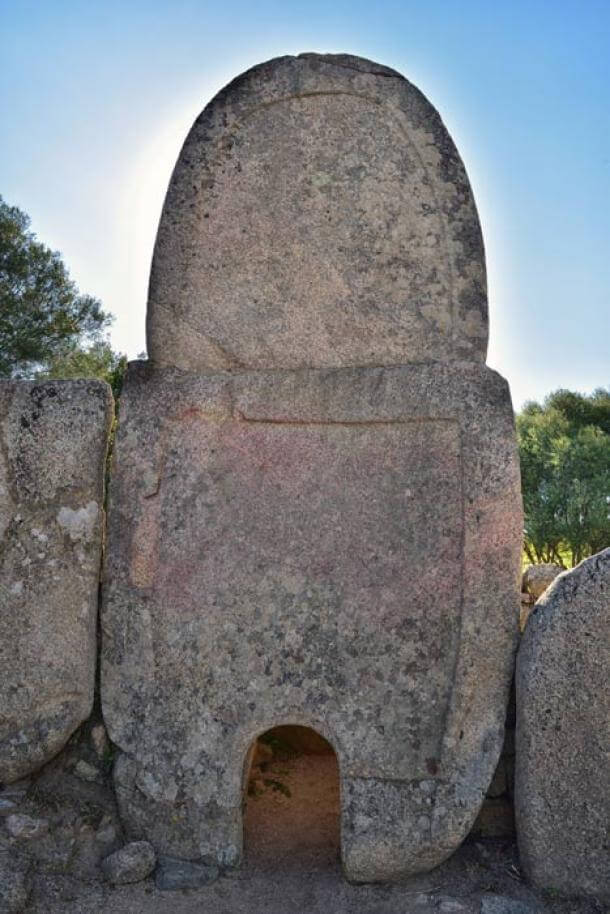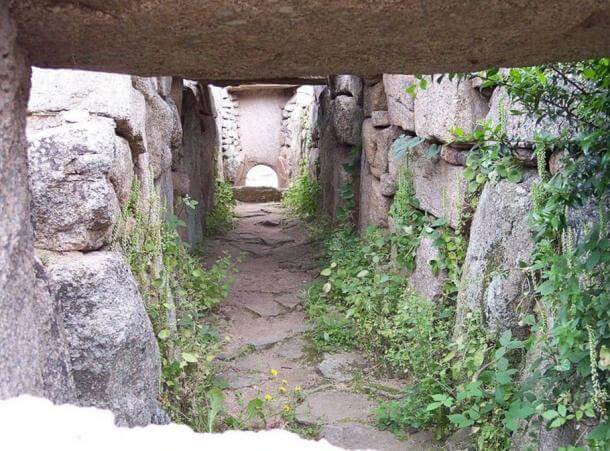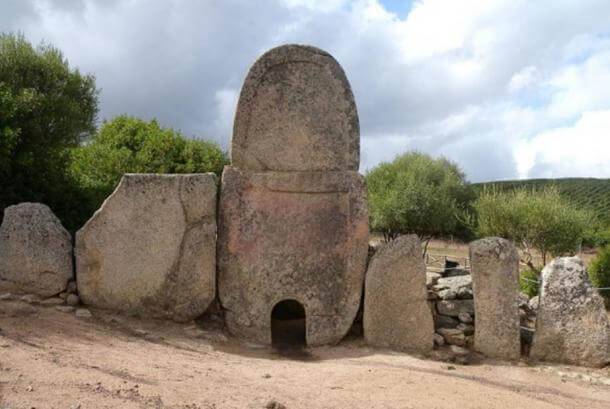
Abaddon
 26. 04. 2024
26. 04. 2024



 16. 03. 2020
16. 03. 2020

During the Bronze Age (3300 - 700 BC), the Nuragic civilization in Sardinia built megalithic buildings known as the Tombs of the Giants (Tombe dei Giganti). These megalithic gallery tombs were used for community burials - the regular burial of members of society seemingly without distinction of their social status. The enormous dimensions of the giant tomb in Coddu Vecchio, Sardinia, one of the remnants of a fascinating and mysterious period of human history, are truly spectacular and provide us with information about the funeral rituals of the day. However, they also raise many questions that have not yet been found satisfactory.
Nuragic civilization built two types of tombs. “The slab type‟ was built of huge stone slabs that were erected and partially sunk into the ground. The plates were placed close together in a long row. Their height is relatively uniform except for the middle stone called the central stele, which is considerably higher. The central stele, towering up to 4 meters in height, significantly exceeds the other stones and a hole is cut at its bottom. Sometimes it can be decorated with engravings and its apex is rounded. In some tombs, the center stone does not stand out so much and bears no signs of working or decorating down to the characteristic opening. Behind it is a rectangular tomb and burial chamber measuring 5 - 15 meters in length and 1 - 2 meters in height. Originally, these tombs were covered with a layer of clay and turf. The second type of giant tomb is the “block type.” Large rectangular blocks were used instead of stone slabs. The tombs at Codd Vecchio are of the plate type.

Tomb of a giant in Coddu Vecchio in Sardinia.
Although the name "Tomb of the Giants" evokes the idea of the burial of a huge man, these tombs only contained burials of commonly tall people, members of the Nuragic civilization. The massive dimensions of the stones used for their construction, some up to 30,5 meters high, and the dimensions of the burial chamber itself gave rise to legends that giants were buried in these tombs. However, no remains of giants have been discovered at this site. The word giant refers to the fact that these tombs were used as community and thus used by society as a whole. In Sardinia, 321 such tombs were discovered, including those in Coddu Vecchio. The tombs of the giants at Codd Vecchio, however, are mysterious in that we do not know the ceremonies and rituals that took place here, nor what symbolic images they have evoked in their builders. It is believed that typical inlets to the tomb were to provide entry into the underworld. These openings served as the boundary between the physical world and the underworld. The survivors and other members of society were likely to offer sacrifices to the ghosts of the deceased or initiation rituals before them.

Although this tomb looks like a giant, only the remains of normally large people were found here.
It is speculated that these sites are located on powerful sources of natural energy and that they have been deliberately selected as burial sites. There are "tellurian currents and strong magnetic forces" in the tombs of the giants, and the people of nuragic civilization seemed to know how to use these forces for burial and ritual purposes. Positive energy emerging from this area was used as a source for "supernatural" healing and maintaining vitality. Such positive energy could not only help the deceased to transition to the afterlife, but could also play an important role in initiation ceremonies. The stone slabs were arranged in a semicircle, perhaps for the purpose of capturing the telluric forces and concentrating them into the central stone.
This energy, collected in the center stone, could be further used by humans to heal and communicate with ancestors and ghosts. The sick and wounded were laid near the stones in order to concentrate the energies in them to facilitate their recovery. This energy was also important for the deceased because it could help to separate their soul from the physical body.

The opening in the central stele is considered a passage into the spiritual world of ancestors and gods.
Certainly, the tombs of giants raise more questions than they provide. Although they allow an insight into the burial customs of ancient civilizations, they do not reveal more than the physical form of the structure and the fact that they were used for funerals. Since the spiritual and religious life of the society at that time was so different from today's society, it is clear that the reconstruction of the funeral rituals at that time will necessarily be only hypothetical. Most of the attention seemed to have been focused on the safe passage of the dead into the underworld, ensuring a smooth transition from the physical plane here to Earth to the spiritual plane, and possibly transmigration into a new life. Giant tombs are community tombs with a large number of buried. Unlike the tombs of the nobility or the elite, regularly used community tombs help to look into the culture and traditions of the majority population of this ancient civilization.
A book in which everything is essential but at the same time is not overwhelmed by incomprehensible terms and dates. With her help, even small children begin to perceive learning history as a wonderful adventure. Large and impressive illustrations leave an indelible impression. Children can read simple messages in comic book bubbles.
